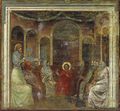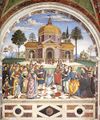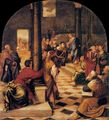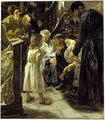Category:Childhood of Jesus (subject)
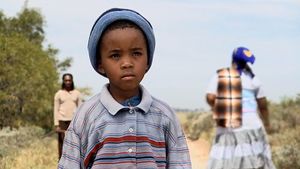
Childhood of Jesus refers to the events in the life of Jesus of Nazareth following his Nativity, before the "undocumented" Hidden Years that preceded the beginning of his Ministry.
- Jesus at Nazareth -- Jesus among the Doctors
- Cf. Madonna and Child -- Joseph and Jesus -- Holy Family
< Life of Jesus : Nativity of Jesus -- Childhood of Jesus -- Jesus' Hidden Years -- Ministry of Jesus (Parables of Jesus, Miracles of Jesus) -- Passion of Jesus -- Resurrection of Jesus -- Relics of Jesus >
Overview
The Gospel of Luke and especially the Infancy Gospel of Thomas are the only ancient sources dealing with these years in the life of Jesus of Nazareth. The narratives are driven by theological concerns and have little historical value. Due to the lack of documentation, scholars and artists can only speculate on the whereabouts of Jesus as a boy growing up at Nazareth.
In 6th-7th cent., the History of Joseph the Carpenter adds a few elements to the tradition. In a speech to his disciples, Jesus himself reveals how much he loved his parents. Joseph in reality was his stepfather, who took in his care in his house Mary, when he was 90 years old and Mary twelve. Jesus was born when Mary was 15 and ever since he lived with his parents and two step-brothers (Judas and James the Less) Joseph had from a previous marriage. Joseph died when he was 111 years old and Jesus eighteen; see Jesus' Hidden Years.
Childhood of Jesus, in ancient sources
History of Joseph the Carpenter (6th-7th cent.)
11. Now Justus and Simeon, the elder sons of Joseph, were married, and had families of their own. Both the daughters were likewise married, and lived in their own houses. So there remained in Joseph's house, Judas and James the Less, and my virgin mother. I moreover dwelt along with them, not otherwise than if I had been one of his sons. But I passed all my life without fault. Mary I called my mother, and Joseph father, and I obeyed them in all that they said; nor did I ever contend against them, but complied with their commands, as other men whom earth produces are wont to do; nor did I at any time arouse their anger, or give any word or answer in opposition to them. On the contrary, I cherished them with great love, like the pupil of my eye.
Childhood of Jesus, in the arts
- Jesus Doctors Schäufelein.jpg
Childhood of Jesus, in the movies
Only a limited number of Jesus movies showed interest in the Childhood of Jesus, rather focusing of his Nativity, Miracles, and Passion.
The first lengthly movie on the Life of Jesus, La vie et la passion de Jésus-Christ (The Life and Passion of Jesus Christ / 1903 Zecca, Nonguet), film, devoted to the Childhood of Jesus two scenes, which were quite different in tone. "The Holy Family at Nazareth" offers a quite "realistic" picture of Jesus working with his father, while "Jesus among the Doctors" is more formal and stereotyped in its presentation of the "canonical" subject. See YouTube.
The realistic path was followed by the "Protestant" From the Manger to the Cross (1912 Olcott), film. An experienced child actor, Percy Dyer, was hired to play the part and the film was shot on locations, in Palestine and Egypt. Olcott drew inspiration from the work of James Tissot and the few silent scenes involving Young Jesus were a reenactment of some of Tissot's most famous paintings; cf. Life of Jesus (1894 Tissot), art. See YouTube.
The influence of James Tissot is noticeable also in Christus (1916 Antamoro), film. The "Catholic" movie, also shot "on locations," offered however a quite stereotyped picture of Jesus as a child modeled on his adult life. The theological concern was to stress that Jesus had since his childhood a clear self-consciousness of his messianic role, to the point that Young Jesus is shown constantly followed by a group of children "disciples," whom he leads, and preached to, with authority. See YouTube.
In 1972 Jesús, María y José (1972 Zacarías), film is the first movie entirely to focus on the childhood of Jesus at Nazareth and speculate on his whereabouts as a boy. The Mexican movie was traditional in its approach to the subject; the father of Jesus, Joseph of Nazareth, was portrayed as an old man acting as a guardian or grandfather of Jesus. Yet the script had necessarily the create an original narrative, besides the Lukean episode of Jesus among the Doctors, so inaugurating a new genre that would be soon followed by other movies.
In Jesus of Nazareth (1977 Zeffirelli), film, the TV miniseries format gave the opportunity to elaborate on Jesus' childhood, devoting two major scenes to the subject. Child actor Lorenzo Monet was chosen for his blond hair and distinctive blue eyes. Filmmaker Franco Zeffirelli's goal was to create a sharp contrast between Jesus' appearance, on one hand, and on the other, the "normality" of his family (Joseph now had the age and behavior of a real father) and the very realistic Jewish setting in which Jesus lived. The contrast reminded the viewers that Jesus, although living in this world, did not really belong to it but came from "elsewhere." The setting of the first scene is the synagogue of Nazareth. Zeffirelli insisted in having Young Jesus perform a Bar Mitzvah ceremony, even though consultant Rabbi Albert Friedlander reminded him that such ceremonies were practiced only from the 15th century. Friedlander tried to teach Lorenzo Monet to read a short portion of the Pentateuch in Hebrew, though he mumbled it and the director was not satisfied (eventually the reading was done mostly in English). The ceremony is interrupted by the arrival of Roman soldiers, which allows the filmmaker to stress the reality of Roman occupation and the violent opposition of the Zealots. The second scene illustrates the "biblical" episode of Jesus among the Doctors in the Temple of Jerusalem.
Another successful TV miniseries, Un bambino di nome Gesù (1987 Rossi), film, focused in 1987 entirely on the childhood of Jesus at the time of the stay of the Holy Family in Egypt until their return to Nazareth. Joseph was still older than Mary but like in Zeffirelli, was a mature man in the fullness of his strength. The plot was only vaguely related to the Gospel of Matthew. As a boy Jesus had to escape a murder attempt by Herod Archelaus and grew up more and more conscious of his destiny.
Jesus movies continued occasionally to include a few scenes on Young Jesus, most notably, JJesus (1979 Sykes, Krisch), film (following the Gospel of Luke). The Son of Man (2005 Dornford-May), film and Color of the Cross (2006 LaMarre), film offered the first portrays of Jesus as a black child.
In 2006 a third movies appeared to focus entirely on the childhood of Jesus, after Jesús, María y José (1972 Zacarías), film and Un bambino di nome Gesù (1987 Rossi), film. In La sacra famiglia (2006 Mertes), film, Joseph was a widower and father of three sons, who struggled to understand the true identity of the new child, born from his virgin wife. The movie followed the canonical gospels in the description of the events of the nativity of Jesus, and apocryphal narratives related to his childhood. As Young Jesus began manifesting his healing powers, suspicious and fear spread among his own relatives and neighbors.
Finally, Io sono con te (2010 Chiesa), film, while following the traditional narrative, shifted the emphasis on the anti-conformist education Jesus received from his high-spirited and independent mother, who taught his son to ask questions and challenge the tradition.
@2014 Gabriele Boccaccini, University of Michigan
Percy Dyer as Young Jesus in From the Manger to the Cross (1912 Olcott), film
Young Jesus in Christus (1916 Antamoro), film
David Bravo as Young Jesus in Jesús, María y José (1972 Zacarías), film
Lorenzo Monet as Young Jesus in Jesus of Nazareth (1977 Zeffirelli), film
Matteo Bellina as Young Jesus in Un bambino di nome Gesù (1987 Rossi), film
Young Jesus in The Son of Man (2005 Dornford-May), film
Brando Pacitto as Young Jesus in La sacra famiglia (2006 Mertes), film
Alex Collins as Young Jesus in Color of the Cross (2006 LaMarre), film
Mohamed Idoudi as Young Jesus in Io sono con te (2010 Chiesa), film
See also:
- "Uncredited child actor" as Young Jesus in La vie et la passion de Jésus-Christ (The Life and Passion of Jesus Christ / 1903 Zecca, Nonguet), film
- Asher Cohen as Young Jesus in I giardini dell'Eden (The Garden of Eden / 1998 D'Alatri), film
External links
- [ Wikipedia]
Pages in category "Childhood of Jesus (subject)"
The following 66 pages are in this category, out of 66 total.
1
- Jesus among the Doctors (1262 Roslin), art
- Jesus among the Doctors (1306 Giotto), art
- Jesus among the Doctors (1310 Giotto), art
- Return of the Holy Family from Jerusalem (1310 Giotto), art
- Jesus among the Doctors (1311 Duccio), art
- Christ Discovered in the Temple (1342 Martini), art
- Jesus among the Doctors (1452 Angelico), art
- Young Jesus and John the Baptista (1475c Pinturicchio), art
- Jesus among the Doctors (1499 Stumme), art
- Jesus among the Doctors (1501 Pinturicchio), art
- Jesus among the Doctors (1504 Cima), art
- Jesus among the Doctors (1505 Schäufelein), art
- Jesus among the Doctors (1511 Matsys), art
- Jesus among the Doctors (1520 Strigel), art
- Jesus among the Doctors (1521 Dürer), art
- Jesus among the Doctors (1526 Ferrari), art
- Jesus among the Doctors (1545 Pitati), art
- Jesus among the Doctors (1558 Veronese), art
- Madonna and Child with St Anne (1606 Caravaggio), art
- Jesus among the Doctors (1610 Borgianni), art
- Childhood of Christ (1620 Honthorst), art
- Jesus among the Doctors (1625 Serodine), art
- Jesus among the Doctors (1630 Murillo), art
- Young Jesus and John the Baptist (1640 Reni), art
- Christ and the Virgin in the House at Nazareth (1640 Zurbarán), art
- St. Joseph with the Child Jesus (1642 La Tour), art
- St. Joseph and the Christ Child (1648 Herrera), art
- Christ the Good Shepherd (1660 Murillo), art
- Holy Family (1682 Murillo), art
- Jesus among the Doctors (1730 Kern), art
- Jesus among the Doctors (1743 Pannini), art
- Jesus among the Doctors (1765 Bergl), art
- Our Saviour Subject to His Parents at Nazareth (1847 Herbert), art
- The Finding of the Saviour in the Temple (1860 Hunt), art
- Christ among the Teachers (1860 Makovsky), art
- Jesus among the Doctors (1862 Ingres), art
- Jesus among the Doctors (1879 Liebermann), art
- Jesus among the Doctors (1881 Hofmann), art
- But Mary Kept All These Things and Pondered Them in Her Heart (1888 Havers), art
- L'Évangile de l'enfance de Notre Seigneur Jésus-Christ selon saint Pierre (1894 Mendès & Schwabe), arch-fi
- Jesus among the Doctors (1894 Tissot), art
- Jesus Found in the Temple (1894 Tissot), art
- Young Jesus (1894 Tissot), art
- Young Jesus and His Mother at the Fountain (1894 Tissot), art
- Jesus among the Teachers (1896 Polenov), art
- The Education of Christ: Hill-Side Reveries (1902 Ramsay), book
- Madonna and Child (1903 Bouguereau), art
- La vie et la passion de Jésus-Christ (The Life and Passion of Jesus Christ / 1903 Zecca, Nonguet), feature film
- Madonna and the Child Christ (1906 Mackennal), art
- Carpenter's Shop (1913 Stott), art
- Holy Family in the Workshop (1921 Fugel), art
- The Christ Child (1931 Petersham), children's novel
- The Childhood of Jesus (1937 Cummins), vision
- Novela maravillosa de la infancia de un Dios (1940 Berninsone), novel
- Die verborgenen Jahre Jesu = Les années obscures de Jésus (1962 @1960 Aron / Mahr), non-fiction (German ed.)
- Gli anni oscuri di Gesù = Les années obscures de Jésus (1963 @1960 Aron / Miniussi), non-fiction (Italian ed.)
- The Boy (1970 O'Neill), novel
- Jesus Tales (1980 Linney), novel
- Marie de Nazareth (Mary of Nazareth / 1995 Delannoy), feature film
- Mary, Mother of Jesus (1999 Connor), TV film
2
- Maria, figlia del suo figlio (Maria: Daughter of Her Son / 2000 Costa), TV film
- Father and Son (2002 Gauthier), art
- (+) Lamb (2002 Moore), novel
- Color of the Cross (2006 LaMarre), feature film
- La sacra famiglia (The Holy Family / 2006 Mertes), TV mini-series
- La infancia de Jesús/Jesus' Childhood: Texto bilingüe del Evangelio apócrifo del Pseudo-Tomás/Bilingual Text of the Apocryphal Gospel of Pseudo-Thomas (2009 Aasgaard), book (Spanish ed.)
Media in category "Childhood of Jesus (subject)"
The following 14 files are in this category, out of 14 total.
- 1850 * Millais (art).jpg 800 × 486; 133 KB
- 1912 Olcott (film).jpg 300 × 460; 49 KB
- 1916 Antamoro (film).jpg 1,382 × 1,761; 278 KB
- 1960 * Aron.jpg 300 × 400; 22 KB
- 1962-T * Aron en.jpg 177 × 285; 5 KB
- 1972 Zacarias (film).jpg 214 × 317; 24 KB
- 1977 * Zeffirelli (TV miniseries).jpg 263 × 475; 43 KB
- 1979 Sykes (film).jpg 277 × 500; 53 KB
- 1985 * Holmes (novel).jpg 1,125 × 1,500; 197 KB
- 1987 Rossi (TV miniseries).jpg 200 × 280; 19 KB
- 1998 D'Alatri (film).jpg 348 × 488; 25 KB
- 2006 * Dornford-May (film).jpg 300 × 429; 40 KB
- 2010 Chiesa (film).jpg 472 × 669; 146 KB
- 2016 Nowrasteh (film).jpg 214 × 317; 14 KB



